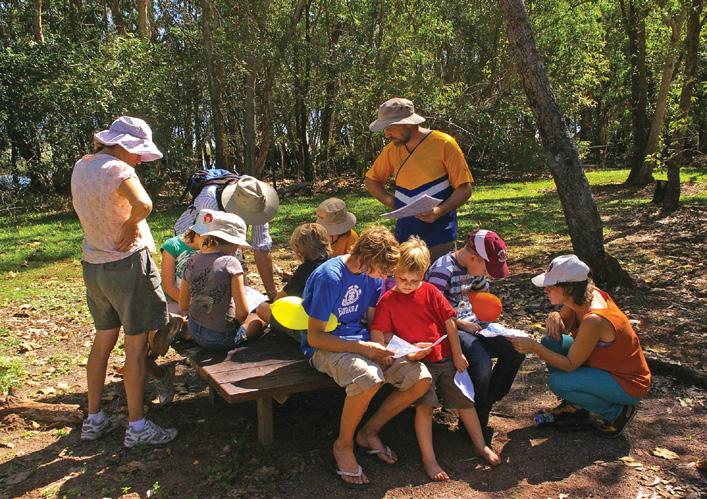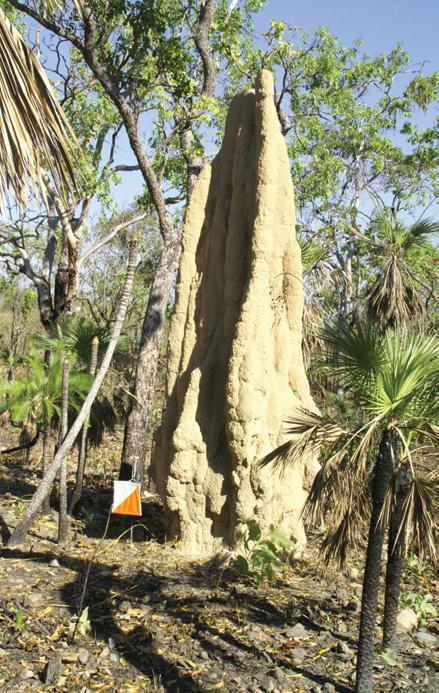
9 minute read
NT CHAMPS
Northern Territory
Championships
Blair Trewin
The Top End’s stalwarts were joined by a keen group of interstaters for the 2009 Northern Territory Championships weekend, which took place over the first weekend in July. There were, in total, about 60 participants in the three events, starting with a Sprint at Charles Darwin University in suburban Darwin before moving to the forests south of Darwin for the Middle and Long Distance events. The Top End is a long way from the terrain that most southerners are used to competing on, so it was not surprising that the terrain types were somewhat different to what they are used to. There is not much tropical rainforest to be found in the Northern Territory (the dry season is too dry for that), and most of the north is covered by relatively open savannah woodland; the critical factor in runnability is how recently the terrain has been burnt. About one-third of the Top End is burnt each year so it is rare to find an area that hasn’t seen fire for a long time, but where those areas exist the grass is very challenging to get through. On the ground, the main feature of the weekend maps was the extreme rockiness of the ridges underfoot. There are not a lot of big rock features, but the areas were covered with small rock which could be quite awkward to run on. The flatter areas featured gully-spur terrain and many termite mounds, some of them very big. There was even the odd buffalo wallow – a feature you certainly won’t see down south – but no water features large enough to support any crocodiles. Conditions were relatively kind; after a hot and humid week leading in, a wind change on the Saturday morning brought dry air and race temperatures in the low 20s, although that still would have felt warm to those coming directly from the south. The Long Distance event, at Coomalie Creek, about 90 kilometres south of Darwin, was based around the old Coomalie airstrip, where there was a significant military presence during World War II (the event area was dotted with war relics). The airstrip also provided the venue for entertainment which occupied much of Saturday afternoon between races, as a number of vintage aircraft provided an informal airshow (with many orienteers taking the opportunity to take a ride in a Tiger Moth or other aircraft of a similar vintage). Despite the small fields, there was some good competition to be had. Perhaps the most keenly-awaited battle was that in M21, between now-local Lachlan Hallett and Victorian Blair Trewin. This almost failed to eventuate thanks to the latter being stuck in Western Australia for some days with a broken-down car, but in the end he only missed the Sprint (from which Hallett was also absent as course-setter). They ended the weekend with honours even; Hallett took out the Middle Distance, but Trewin reversed the result in the Long Distance event despite having a shoe partially disintegrate in mid-course. Another good contest was that in M17-20, featuring two of Australia’s better M16s, Oliver Poland and local Kelly Bertei, along with Poland’s older brother Luke. Oliver was particularly impressive in the Sprint (not for the first time this season), in which he had the fastest time of anyone on the long course, and also led a Long Distance field in which the three were separated by only five minutes. In between, Luke took out the Middle Distance. Susanne Casanova, also a new(ish) Darwin resident, was untroubled in taking out the Middle and Long Distance in W21. Kate Radford provided her closest competition in these events but was unable to take advantage of Casanova’s absence in the Sprint, which was won by Victorian Ann-Cathrin Degn. The interstate contingent were responsible for two of the more interesting Long Distance races. The gap was just under two minutes in W45, where Gayle Quantock (Queensland) edged out Toni Brown (ACT), and Liz Bourne’s win over Janet Davill in W55 was similarly close. It was a weekend of enjoyable Orienteering for most concerned. For those who do not head for Europe for the winter, the Territory provides a chance for a new Orienteering experience without leaving Australian shores, and also has potential as a warm weather training venue for those about to compete in hot countries (at least for people with strong ankles). The next major event is expected to take place in mid-2011.
A 1942 Harvard flyover. Photo: Adam Liedloff
Luke Poland. Photo: Wolfgang Meike
Top End Juniors
Julianne Giffard


Asmall but enthusiastic group of young orienteers gathered on the shores of Manton Dam near Darwin on Saturday July 4. Some had just completed or attempted the very rocky Middle Distance course with varying degrees of success as part of the NT Championship carnival week-end. All were keen to improve their orienteering skills with the help of the Blue Sparks ACT Primary School Team lead by David Poland and Toni Brown who had brought their family to the Top End for the Championships. The children, ranging in age from 5 to 11, along with their older siblings and parents (who learnt a few things too) practised their map reading skills with a star course relay race based around a 1:2500 enlarged and easy-to-read map of the lake shore and picnic area. Various features were identified on the map such as vegetation boundaries, thickets, spurs, bridges and other man-made objects. David used his knuckles to illustrate contours and a saddle and the children had to identify areas of varying degrees of steepness by using the contours. An activity alluded to but not demonstrated and perhaps more suited to southern climates was edible orienteering using porridge, milk and lollies to demonstrate different terrain and features. After completing a treasure hunt and balloon orienteering the children were ready to face the challenges at the rocky and sometimes overgrown terrain at Coomalie Creek the next day. Noah Poland, who had already won the Sprint and Middle Distance events, capped off a great week-end by winning the M10 course in a blistering time. Three of the other children became NT Champions in their respective categories. The most successful local junior under the age of fourteen was the winner of the W12, Jilly Storrs, who had also picked up a second and third in the Sprint and Middle Distance events respectively. Thanks to David and Toni for showing the Top End Orienteering children how much fun Orienteering can be.
Map reading practice. Photo: Wolfgang Meike
David Poland demonstrates contours on his knuckles. Photo: Wolfgang Meike


Aerial view of the assembly area at Coomalie Farm. Photo: Adam Liedloff



Susanne Casanova and Adrian Uppill after the sprint event. Photo: Wolfgang Meike Sunset over the Timor Sea after the sprint event. Photo: Wolfgang Meike

Tyson Hillyard, Long event winner in M21AS. Photo: Wolfgang Meike


Liz Bourne, winner of W55A receives her commemorative medallion from Richard Luxton. Photo: Adam Liedloff Kelly Bertei running across Dripstone cliffs in the sprint event. Photo: Wolfgang Meike
A Pleasant Sojourn to the Top End
Bob Mouatt - Red Roos, ACT

For those who can remember how enjoyable Orienteering was in the 1970s and to those who would like to go back in time and experience it, may I recommend the Northern Territory Championships; no SportIdent, and plenty of entertainment. I had the pleasure of fitting part of the 2009 NT Championships into a trip through central and northern Australia. I visited the Sprint Distance event at the Charles Darwin University on the evening of Friday 3 July. After a challenging run through the University and visiting some beach control sites, which at other times would have been covered by a high tide, participants watched the sun set on Beagle Gulf and enjoyed a BBQ on the beach at Dripstone Park. I skipped the Middle Distance event on the Saturday morning as I had other commitments, but attended the pièce de résistance, the dinner at Coomalie Creek airstrip, which had been the base for No 1 Photo Reconnaissance Unit and No 31 Fighter Squadron. The dinner was sumptuous, but the highlight for many was the opportunity to fly in two World War II planes, a Tiger Moth or a Harvard (on which the Australian Wirraway was based). One of my abiding memories was seeing John Lyon in the front of the Tiger Moth looking like Terry Thomas in the movie ‘Those Magnificent Men in Their Flying Machines’. After dinner we were entertained by two musical groups, the Top End Folk Club and a quartet, Sax Seasons, which included the Top End’s own Susi Bertei. Next morning we returned to Coomalie Creek for the Long Distance event, which provided a tough physical and navigational challenge for most competitors. The terrain was covered with tens, if not hundreds, of relics from World War II, as well as many rocky outcrops and termite mounds. To paraphrase Crocodile Dundee, some of the 5 metre plus termies could be described as, “Now that is a termite mound!” The NT Championships attracted around 70 competitors, but every State and Territory (except Tasmania) was represented by at least one person (there were eight from the ACT), plus a lone New Zealander and a couple of Danes living in Australia. The workload for a small club such as Top End Orienteers to stage such a magnificent carnival was enormous and its members might not be able to repeat it every year, but I strongly recommend that orienteers in the south seriously consider heading north when the next NT Championships are held. PS. I can now claim to have joined a small select band of orienteers who has participated in the Long Distance Championships of every State and Territory in Australia. Thank you Top Enders for a most enjoyable weekend.

John Lyon in front cockpit of Tiger Moth
Magnetic anomaly
Adrian Uppill (Onkaparinga Hills, SA)
The need to orientate the map to features in the field rather than using the compass needle is clearly the case when orienteering at Manton Dam, NT. Jon Potter (TEO) had warned of magnetic anomalies over the map but I did not expect a deviation of about 18 degrees west from the north lines when at a particular saddle on the map. The north lines at this point are obviously wrong in that they are not parallel but perhaps should bend as shown on the map subset. Alternatively, in this part of the country, one could use the magnetic termite mounds for orientating the map!











